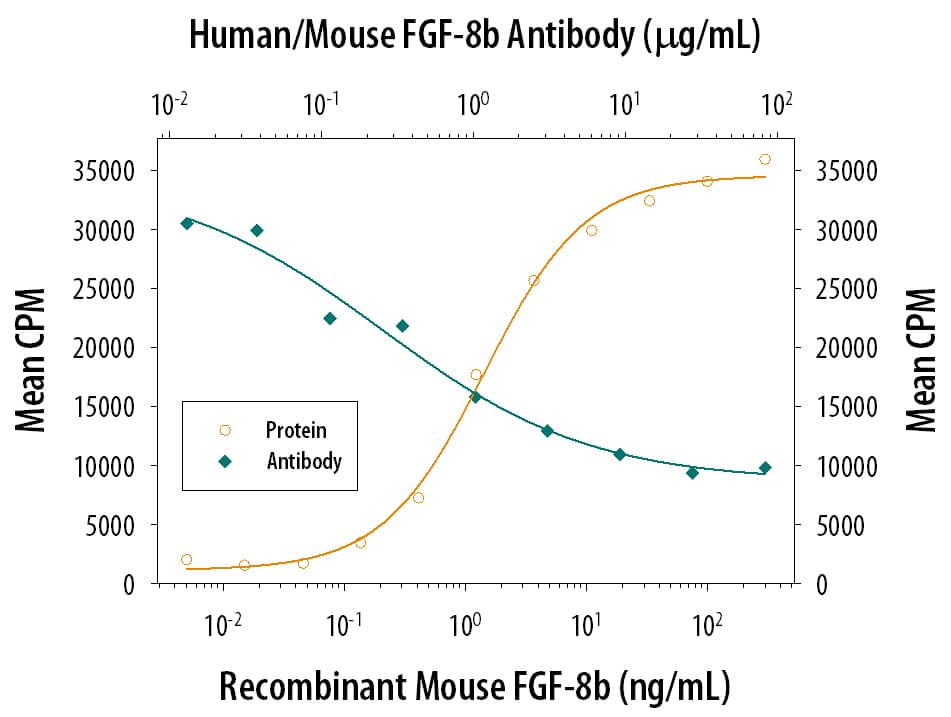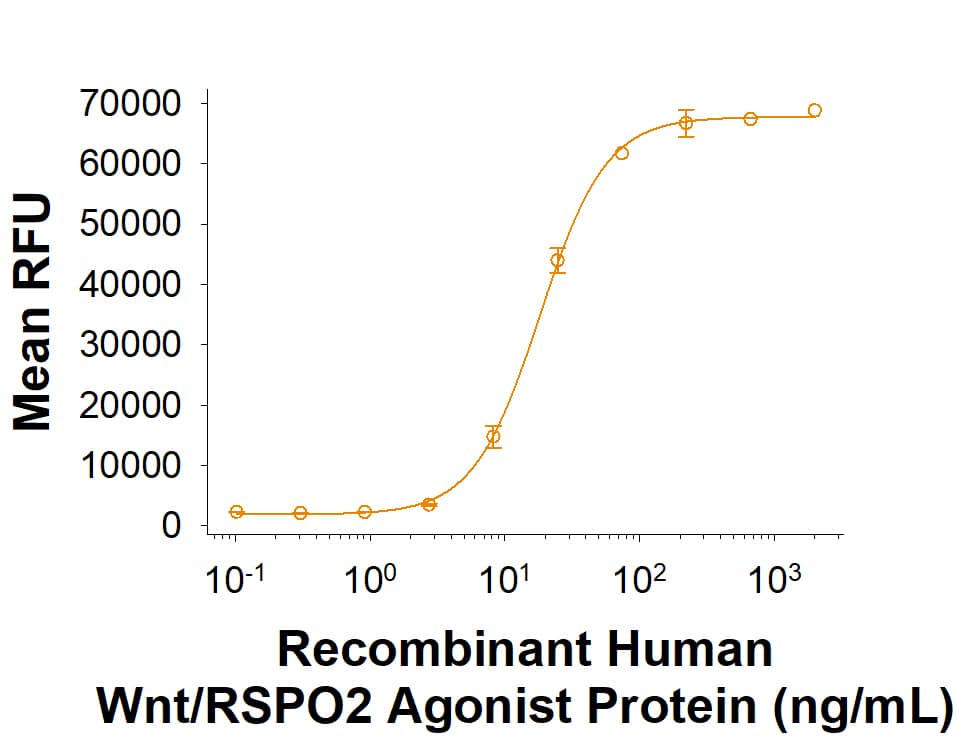Mouse FGF‑8b Isoform Antibody Summary
cross‑react with recombinant mouse FGF-8c in neutralizing bioassay.
Gln23-Arg215
Accession # NP_006110
Customers also Viewed
Applications
Please Note: Optimal dilutions should be determined by each laboratory for each application. General Protocols are available in the Technical Information section on our website.
Scientific Data
 View Larger
View Larger
Cell Proliferation Induced by FGF‑8 and Neutralization by Mouse FGF‑8 Antibody. Recombinant Mouse FGF-8b Isoform (Catalog # 423-F8) stimulates proliferation in the the NR6R-3T3 mouse fibroblast cell line in a dose-dependent manner (orange line), as measured by Resazurin (Catalog # AR002). Proliferation elicited by Recombinant Mouse FGF-8b Isoform (60 ng/mL) is neutralized (green line) by increasing concentrations of Goat Anti-Mouse FGF-8b Isoform Antigen Affinity-purified Polyclonal Antibody (Catalog # AF-423-NA). The ND50 is typically 0.4-2.4 µg/mL in the presence of heparin (1 µg/mL).
 View Larger
View Larger
FGF‑8 in Human Prostate. FGF-8 was detected in immersion fixed paraffin-embedded sections of human prostate using Goat Anti-Mouse FGF-8 b Isoform Antigen Affinity-purified Polyclonal Antibody (Catalog # AF-423-NA) at 15 µg/mL overnight at 4 °C. Tissue was stained using the Anti-Goat HRP-DAB Cell & Tissue Staining Kit (brown; Catalog # CTS008) and counterstained with hematoxylin (blue). Specific staining was localized to epithelial and endothelial cells. View our protocol for Chromogenic IHC Staining of Paraffin-embedded Tissue Sections.
Preparation and Storage
- 12 months from date of receipt, -20 to -70 °C as supplied.
- 1 month, 2 to 8 °C under sterile conditions after reconstitution.
- 6 months, -20 to -70 °C under sterile conditions after reconstitution.
Background: FGF-8
FGF-8 is a member of the fibroblast growth factor family that was originally discovered as a growth factor essential for the androgen-dependent growth of mouse mammary carcinoma cells (1‑3). Alternate splicing of mouse FGF-8 mRNA generates eight secreted isoforms, designated a‑h, but only FGF-8a, b, e and f exist in humans (4). FGF-8 contains a 22 amino acid (aa) signal sequence, an N‑terminal domain that varies according to the isoform (30 aa for FGF-8b; 20 aa for the shortest, FGF-8a), a 125 aa FGF domain and a 37 aa proline‑rich C‑terminal sequence. The FGF domain of FGF-8 shares the most aa identity with FGF17 (75%) and FGF-18 (67%), and the three form an FGF subfamily (2). Mouse FGF-8b shares 100% aa identity with human FGF-8b. FGF-8 is widely expressed during embryogenesis, and mediates epithelial-mesenchymal transitions. It plays an organizing and inducing role during gastrulation, and regulates patterning of the midbrain/hindbrain, eye, ear, limbs and heart in the embryo (2, 5‑8). The isoforms may play different roles in development. FGF-8b shows the strongest receptor affinity and oncogenic transforming capacity although FGF-8a and FGF-8e are also transforming and have been found in human prostate, breast or ovarian tumors (1, 5, 9‑12). FGF-8 shows limited expression in the normal adult, but low levels are found in the reproductive and genitourinary tract, peripheral leukocytes and bone marrow hematopoietic cells (3, 9, 13).
- Mattila, M.M. and P.L. Harkonen (2007) Cytokine Growth Factor Rev. 18:257.
- Reuss, B. and O. von Bohlen und Halbach (2003) Cell Tiss. Res. 313:139.
- Tanaka, A. et al. (1992) Proc. Natl. Acad. Sci. USA 89:8928.
- Gemel, J. et al. (1996) Genomics 35:253.
- Olsen, S.K. et al. (2006) Genes Dev. 20:185.
- Crossley, P.H. et al. (1996) Cell, 84:127.
- Heikinheimo, M. et al. (1994) Mech. Dev. 48:129.
- Sun, X. et al. (1999) Genes Dev. 13:1834.
- Ghosh, A.K. et al. (1996) Cell Growth Differ. 7:1425.
- Mattila, M.M. et al. (2001) Oncogene 20:2791.
- Valve, E. et al. (2000) Int. J. Cancer 88:718.
- Valve, E.M. et al. (2001) Lab. Invest. 81:815.
- Nezu, M. et al. (2005) Biochem. Biophys. Res. Commun. 335:843.
Product Datasheets
Citations for Mouse FGF‑8b Isoform Antibody
R&D Systems personnel manually curate a database that contains references using R&D Systems products. The data collected includes not only links to publications in PubMed, but also provides information about sample types, species, and experimental conditions.
3
Citations: Showing 1 - 3
Filter your results:
Filter by:
-
Fgf20 is required for sensory epithelial specification in the developing cochlea.
Authors: Hayashi T, Ray CA, Bermingham-McDonogh O
J. Neurosci., 2008-06-04;28(23):5991-9.
Species: Mouse
Sample Types: Whole Cells
Applications: Neutralization -
Cardiac arterial pole alignment is sensitive to FGF8 signaling in the pharynx.
Authors: Hutson MR, Zhang P, Stadt HA, Sato AK, Li YX, Burch J, Creazzo TL, Kirby ML
Dev. Biol., 2006-06-12;295(2):486-97.
Species: Chicken
Sample Types: Whole Tissue
Applications: Neutralization -
FGF8 is required for cell survival at distinct stages of nephrogenesis and for regulation of gene expression in nascent nephrons.
Authors: Grieshammer U, Cebrian C, Ilagan R, Meyers E, Herzlinger D, Martin GR
Development, 2005-07-27;132(17):3847-57.
Species: Mouse
Sample Types: Whole Tissue
Applications: Neutralization
FAQs
No product specific FAQs exist for this product, however you may
View all Antibody FAQsIsotype Controls
Reconstitution Buffers
Secondary Antibodies
Reviews for Mouse FGF‑8b Isoform Antibody
Average Rating: 5 (Based on 1 Review)
Have you used Mouse FGF‑8b Isoform Antibody?
Submit a review and receive an Amazon gift card.
$25/€18/£15/$25CAN/¥75 Yuan/¥2500 Yen for a review with an image
$10/€7/£6/$10 CAD/¥70 Yuan/¥1110 Yen for a review without an image
Filter by:
Dilution used - 1:50. The staining was done on an E11.5 mouse transverse section (fixed on 4% PFA overnight) and done using standard IF techniques.
Blocking - 1 hour with 1% BSA before addition of the primary antibody
Secondary antibody - Alexa Fluor Donkey Anti Goat 488





















